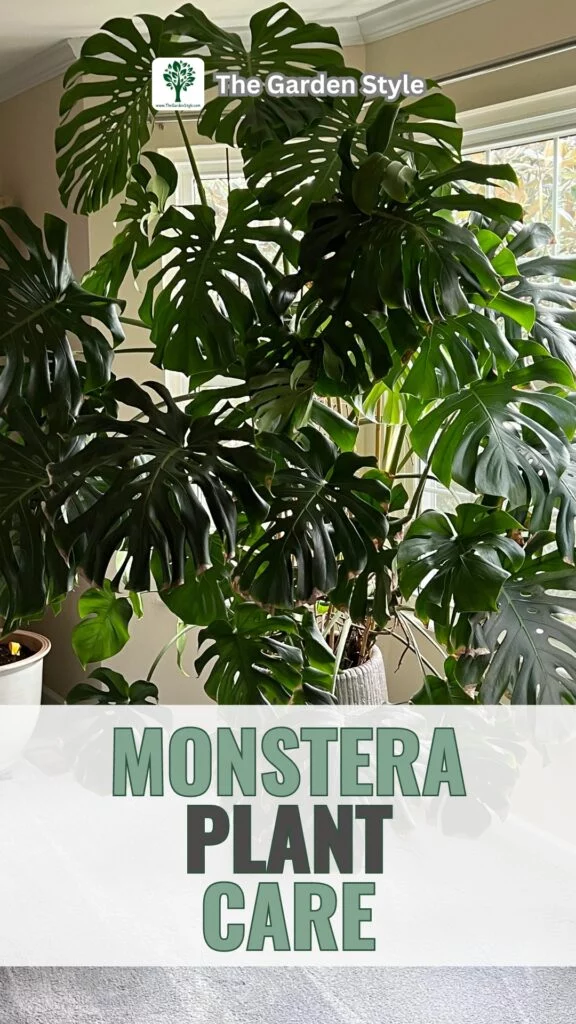The Monstera plant, also known as the Swiss cheese plant, is a tropical beauty that has captured the hearts of plant enthusiasts worldwide. With its large, glossy leaves adorned with natural perforations, it’s no wonder this trendy plant has become a staple in many homes and offices. However, despite its striking appearance, proper Monstera plant care is essential to ensure its long-term health and vitality. In this comprehensive guide, we’ll delve into the secrets of Monstera plant care, covering everything from environmental needs to propagation techniques.
Table of Contents
Origins and Characteristics
Monstera deliciosa, or the “delicious monster,” is a tropical evergreen vine native to Central America. It’s a member of the Araceae family and is known for its distinctive, large leaves, which can grow up to three feet long and two feet wide. As the plant matures, its leaves develop natural perforations, giving them a unique, Swiss cheese-like appearance.
Types of Monstera Plants
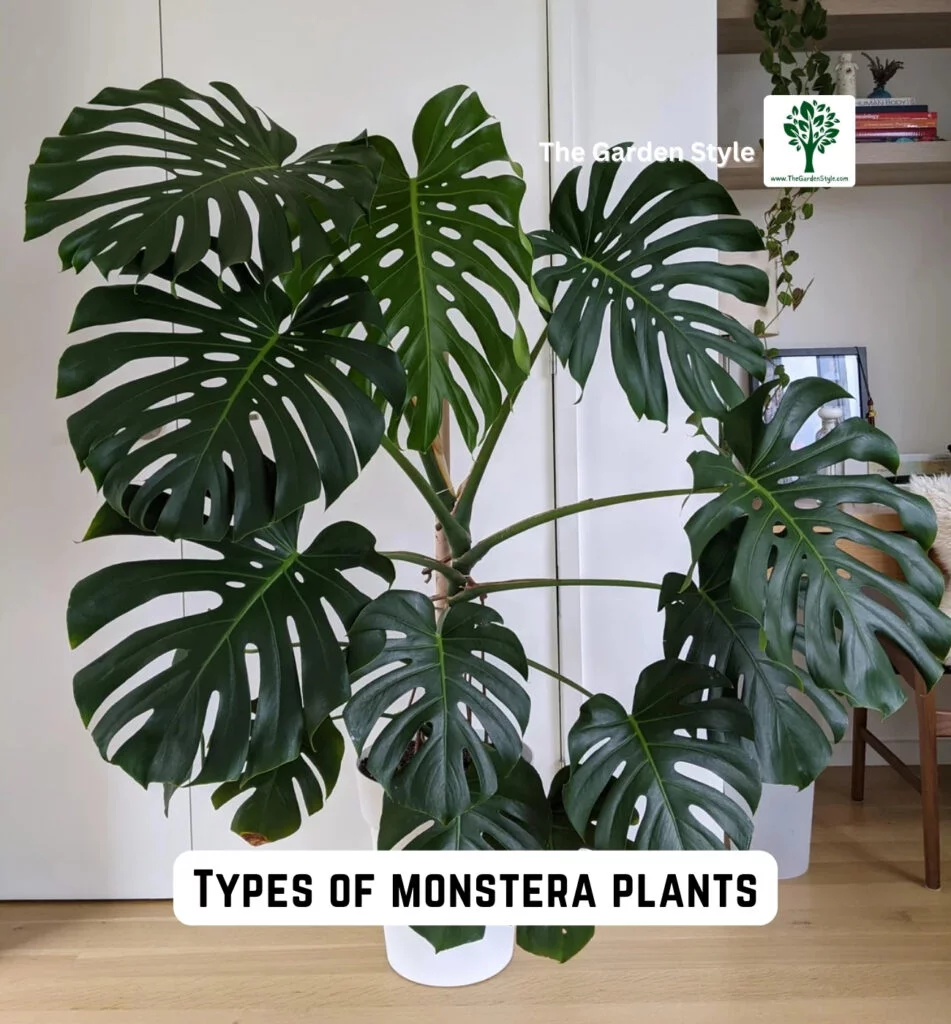
Did you know? While the Monstera deliciosa, also known as the Swiss cheese plant, is the most popular and widely cultivated species, the Monstera genus encompasses several other fascinating varieties. According to Plants of the World, there are over 60 distinct types of Monstera plants! Here are some of the different types:
- Monstera adansonii (Monkey Mask or Swiss Cheese Vine): This trailing or climbing variety is native to Central and South America. It’s characterized by its elongated, heart-shaped leaves with distinctive holes and perforations. The plant can grow up to 20 feet long and makes an excellent choice for hanging baskets or trailing from shelves.
- Monstera obliqua (Monstera Peru or Monkey Mask): This compact Monstera variety is native to Central and South America. Its leaves are large, oval-shaped and feature a distinctive pattern of holes and perforations. The obliqua is often mistaken for the adansonii, but its leaves are more elongated and narrower.
- Monstera siltepecana (Monstera Mexico or Camouflage Plant): Hailing from Mexico, this monstera has smaller, heart-shaped leaves that develop unique patterns of holes and splits as they mature. The siltepecana is a slower-growing variety and can be challenging to find in cultivation.
- Monstera dubia (Shingle Plant or Five Holes Plant): Native to Central and South America, this species is characterized by its distinctively shaped leaves that resemble shingles or tiles. As the name suggests, each leaf typically has five holes or perforations.
- Monstera acacoyaguensis (Monstera from Acacoyagua): This rare and endangered Monstera species is native to a small region in Mexico. It has large, deeply lobed leaves with distinctive perforations and can grow up to 20 feet tall in its natural habitat.
- Monstera karstenianum (Monstera from Karsten): This unique Monstera variety, native to Central America, has long, slender leaves that can reach up to 3 feet in length. The leaves are solid green without any perforations, making it a striking addition to any collection.
While the Monstera deliciosa remains the most popular choice for indoor cultivation, these other varieties offer a range of unique leaf shapes, patterns, and growth habits, appealing to collectors and plant enthusiasts alike.
How to Care for Monstera Plant
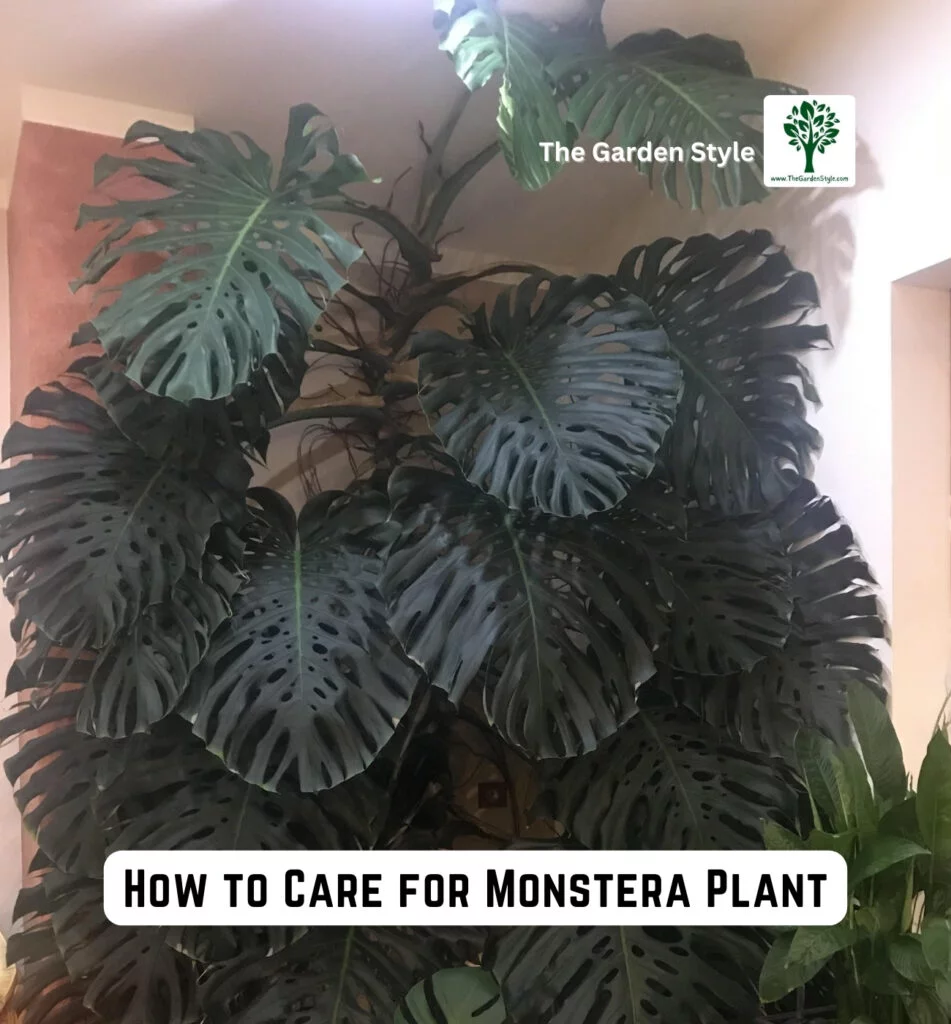
Monsteras, with their iconic split leaves, have become a staple in many homes and offices. While relatively low maintenance, these tropical plants have specific care requirements for thriving. This section covers everything you need to know about Monstera plant care, including light, humidity, watering, soil, fertilizing, and more.
Temperature and Humidity
Monstera plants thrive best in warm, humid environments that mimic their natural tropical habitat. They prefer temperatures between 65°F and 85°F (18°C and 29°C) and high humidity levels around 60% to 70%. If the air in your home is too dry, consider using a humidifier or placing the plant on a pebble tray filled with water.
Light Requirements
While Monstera plants can survive in low-light conditions, they thrive best in bright, indirect sunlight. Placing them near an east or north-facing window is recommended because direct sunlight can scorch their leaves. If you don’t have access to natural light sources, you can supplement with grow lights. These artificial lighting systems mimic the intensity and spectrum of sunlight, allowing your Monstera to receive the necessary light for optimal growth and leaf development. Learn more about the best grow lights for indoor plants.
Proper Watering Techniques
Monstera plants prefer consistent moisture, but they don’t like to sit in soggy soil. Water your Monstera when the top inch or two of soil is dry, and ensure the pot has proper drainage holes. During the growing season (spring and summer), water more frequently and reduce watering in the winter months. Learn more about how often to water Monstera.
Soil for Monstera
Choosing the right soil mix is crucial for Monstera plant care. These tropical beauties thrive in a well-draining, nutrient-rich potting mix that mirrors their natural habitat.
The ideal soil for monsteras should have the following characteristics:
- Well-Draining: Monsteras are susceptible to root rot, so it’s crucial to use a soil mix that drains excess moisture efficiently. A potting mix specifically formulated for epiphytes (air plants) or aroids (plants in the Araceae family) is an excellent choice, as it typically contains ingredients like perlite, bark chips, or orchid bark to improve drainage.
- Airy and Chunky: Monsteras are epiphytic plants, meaning they naturally grow on trees or other surfaces in their native habitats. As such, they prefer a soil mix that is light, airy, and chunky, allowing for proper aeration and water retention.
- Nutrient-Rich: While good drainage is essential, the soil should also be rich in nutrients to support the vigorous growth and lush foliage of your Monstera. Look for potting mixes that contain nutrient-rich ingredients like compost, aged bark, or slow-release fertilizers.
- Slightly Acidic: Monsteras thrive in slightly acidic soil with a pH range of 5.5 to 7. You can adjust the pH level by adding amendments like sphagnum peat moss or coffee grounds to the potting mix.
You can create your own customized Monstera soil mix by combining equal parts of the following ingredients:
- Potting soil or soil-based mix
- Perlite or orchid bark (for drainage)
- Compost or aged bark (for nutrients)
- Sphagnum peat moss (for acidity)
Alternatively, you can purchase a high-quality, well-draining potting mix specifically formulated for epiphytic or aroid plants. To learn about ideal soil options for your Monstera and homemade recipes, check out our article on the best soils for Monstera.
- 100% NATURAL: Special mixture for the plant also known as Ceriman or Swiss Cheese Plant
Fertilizer Needs
Like most plants, monsteras benefit from regular fertilization to support their lush growth and vibrant foliage. Use a balanced, water-soluble fertilizer diluted to half strength every two to four weeks during the growing season (spring and summer).
For optimal results, look for a fertilizer with an NPK (nitrogen-phosphorus-potassium) ratio of 3-1-2 or 5-2-3, which provides the ideal nutrient balance for Monstera plants. These ratios ensure your plant receives adequate nitrogen for leaf growth, phosphorus for root development, and potassium for overall plant health and vigor.
When growth slows down in the winter months, you can reduce fertilization frequency or skip it altogether to avoid salt buildup in the soil. Resume regular feeding in early spring as new growth emerges.
Consistent and appropriate fertilization plays a crucial role in maintaining your monstera’s lush, fenestrated foliage and promoting overall plant vitality. Learn more about Monstera fertilizer.
- 🌱 PERFECT BLEND OF NUTRIENTS – Give your monstera plants everything they need to grow up healthy! Our 3-1-2 liquid concentrate has all of the essential nutrients that your plants crave.
Pests And Plant Diseases on Monstera
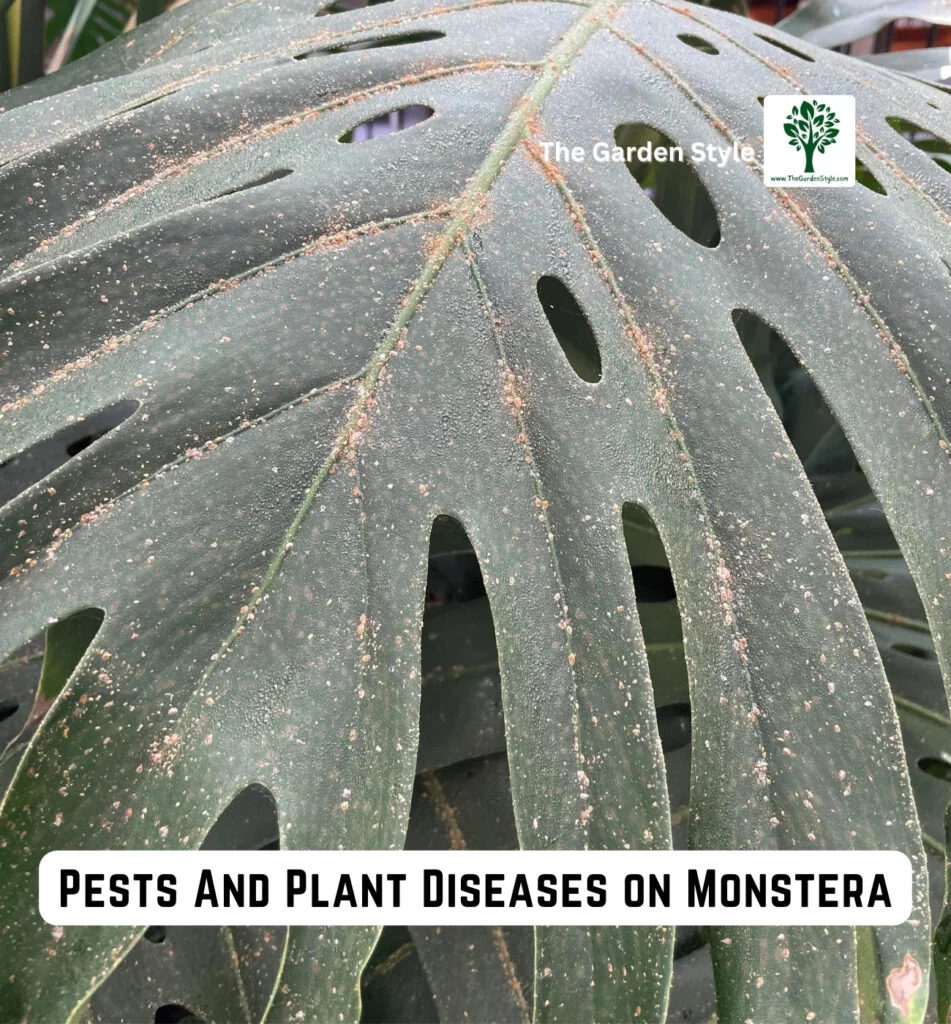
While Monstera plant care is generally straightforward, they can still fall victim to various pests and diseases, especially in suboptimal growing conditions. Being vigilant and taking preventive measures can help keep your Monstera plant healthy and thriving.
Common Pests:
- Spider Mites: These tiny arachnids can quickly infest your Monstera, leaving behind telltale webbing and stippled leaves. Regularly misting the plant and maintaining high humidity levels can deter spider mites.
- Mealybugs: These cotton-like pests congregate in crevices and leaf undersides, feeding on plant sap. Treat with insecticidal soap or neem oil, and isolate infested plants to prevent spreading.
- Scale Insects: These immobile pests appear as brown or black bumps on stems and leaves, sapping plant nutrients. Scrape off with a cotton swab dipped in rubbing alcohol, or use insecticidal soap.
- Fungus Gnats: While not directly harmful to the plant, these tiny flies can indicate overwatering and lead to fungal issues. Allow the soil to dry out between waterings, and use yellow sticky traps to control populations.
Common Diseases:
- Root Rot: Caused by overwatering or poor drainage, root rot can lead to yellowing leaves, wilting, and eventual plant death. Ensure proper drainage and water only when the top inch of soil is dry.
- Leaf Spot Diseases: Fungal and bacterial leaf spots can cause unsightly blemishes and holes in the monstera’s leaves. Improve air circulation, avoid overhead watering, and treat with a fungicide or bactericide if necessary.
- Powdery Mildew: This fungal disease appears as a white, powdery coating on leaves, stunting growth. Increase air circulation, avoid overcrowding, and treat with a fungicide if needed.
- Nutrient Deficiencies: Yellowing leaves, stunted growth, or distorted foliage can indicate a lack of essential nutrients. Use a balanced fertilizer and ensure well-draining soil.
By regularly inspecting your Monstera for signs of pests or diseases and taking appropriate action, you can maintain a healthy, vibrant plant that showcases its stunning foliage.
Common Problems of Monstera
While Monstera plant care is generally straightforward, challenges can arise. Identifying the root cause of your Monstera distress is crucial for its recovery. Here are common symptoms of poor health and how to address them.
Browning Leaf Tips on Monstera
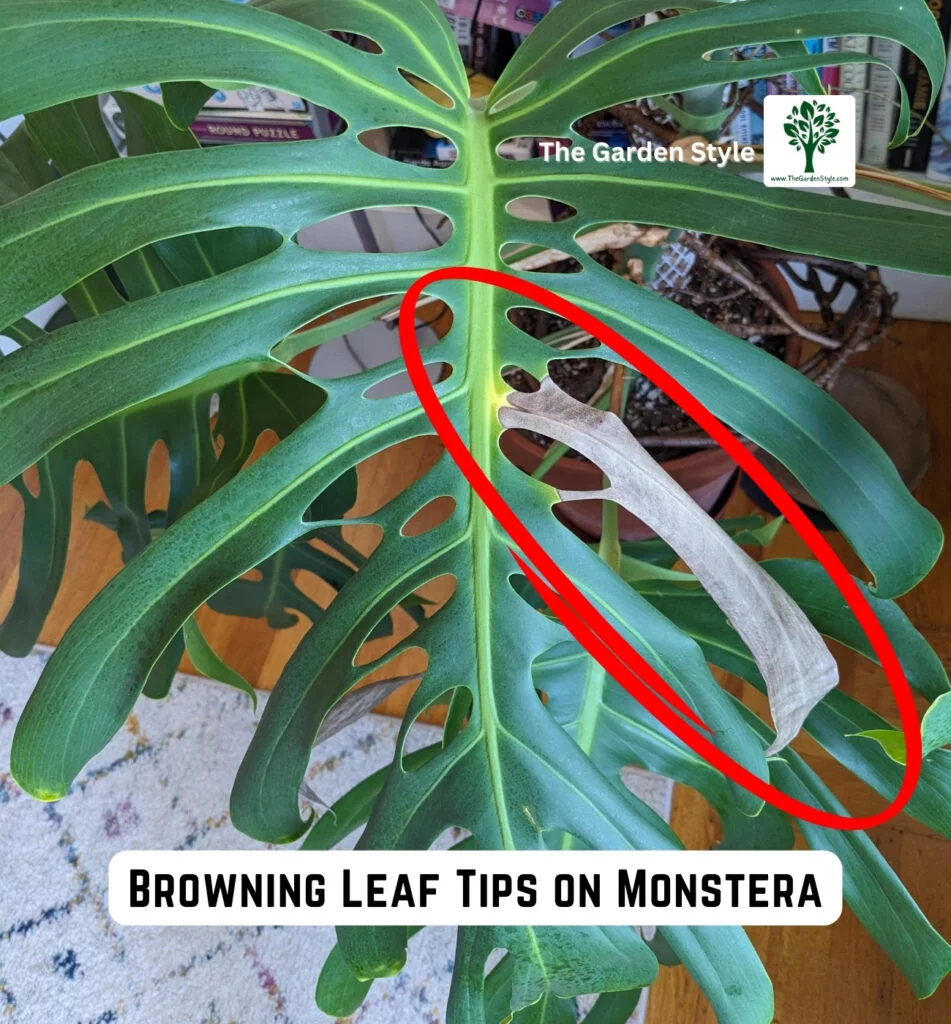
If the Monstera leaf tips are turning brown, it’s often a sign of dry soil or inconsistent watering. Establish a regular watering schedule to maintain consistent moisture levels and remove any affected leaves.
However, if you notice a yellow halo surrounding the brown spots or tips, it could indicate a fungal infection. Promptly remove the affected foliage and allow the soil to dry out before watering again. Overwatering or excessively wet soil can create an ideal environment for fungal growth.
Yellow Leaves or Light Brown Spots on Monstera
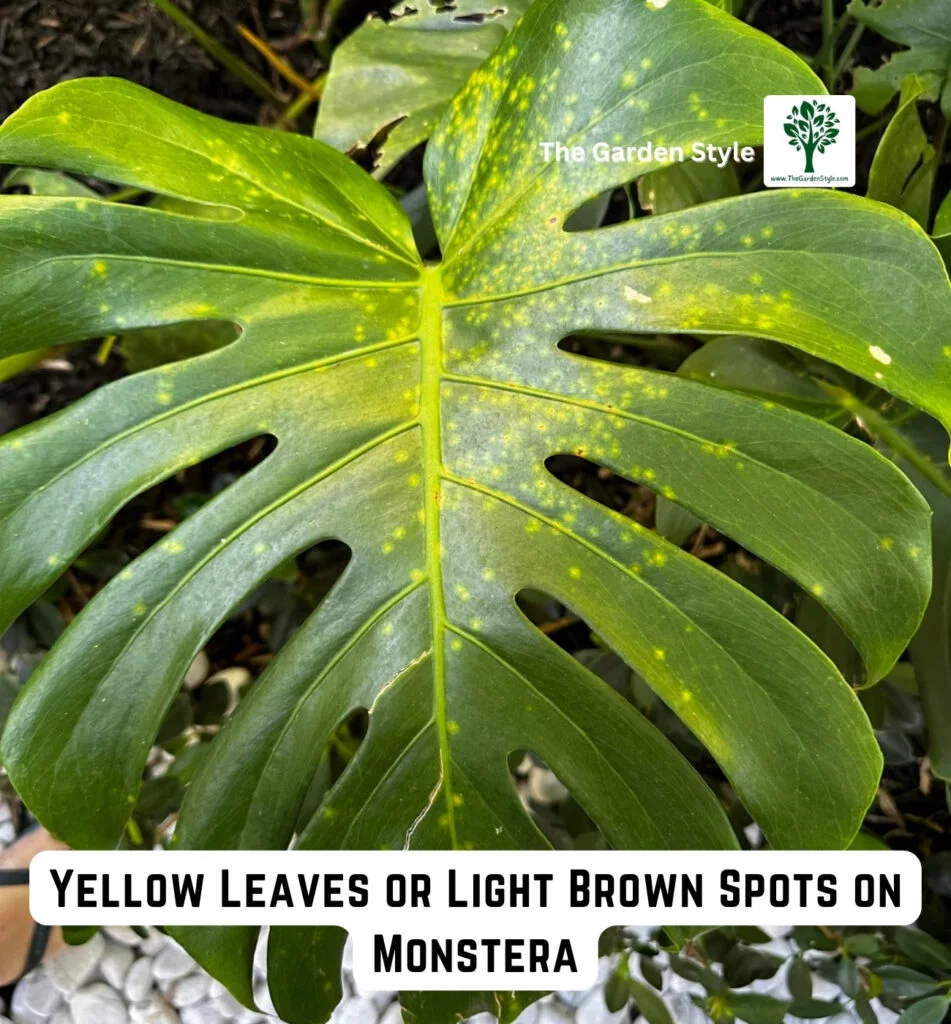
Yellowing leaves typically signify dry soil conditions. The oldest leaves on the plant will be the first to turn yellow. Discard the affected foliage. If you observe dry, crispy spots on the leaves, check the soil – if it’s completely dry, give your Monstera a thorough watering.
Wilting, Curling, or Drooping Leaves on Monstera
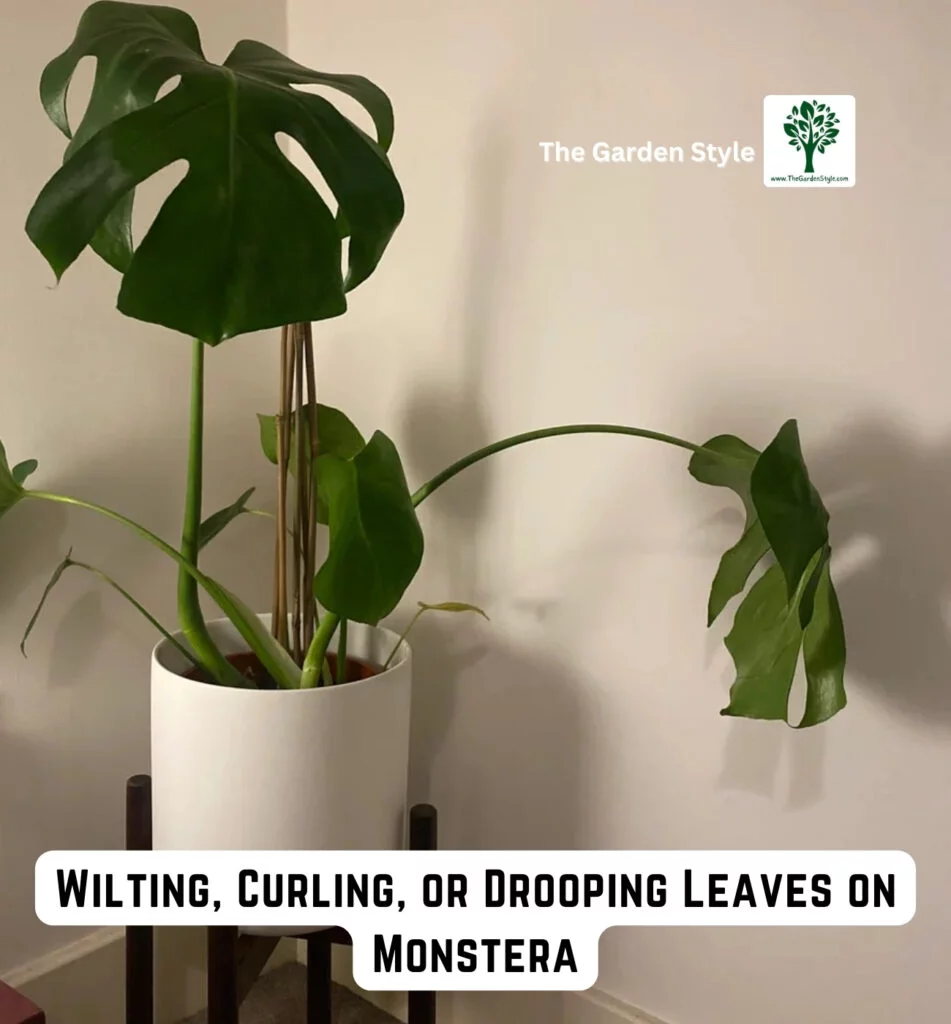
Wilting, curling, or drooping leaves are often a result of improper watering practices. If the top few inches of soil are dry, your plant is likely underwatered. Conversely, if the soil remains overly moist, your Monstera may be suffering from root rot.
Curling leaves can also indicate low humidity levels. Consider placing a humidifier near the plant or moving it away from air conditioning or heating vents.
Carefully remove the plant from its pot to inspect the roots. If the roots appear mushy or rotten due to overwatering, prune away the damaged parts and repot your Monstera in fresh, well-draining soil.
Black Spots on Monstera Leaves
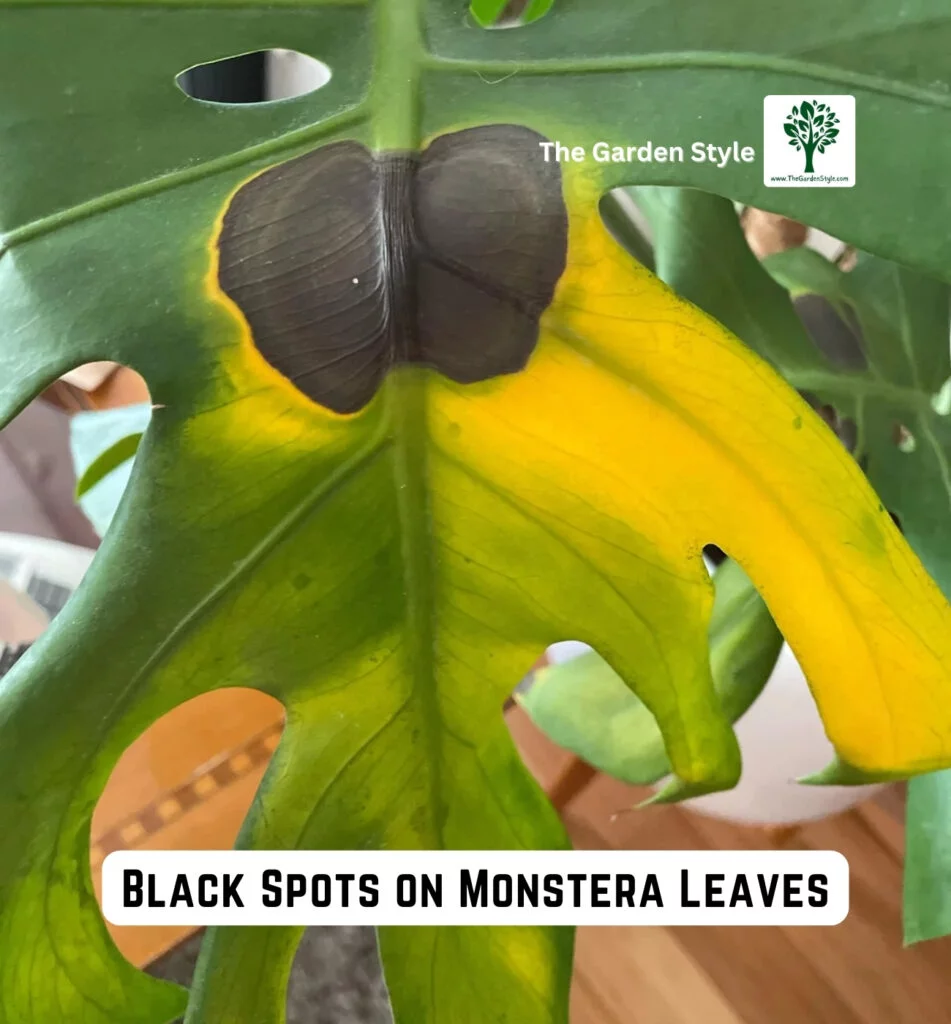
Black spots on the leaves can indicate fungal or bacterial issues. If the spots have a dry, powdery texture, they could indicate a fungal disease. Conversely, moist or slimy black spots may signify a bacterial problem.
Remove any affected leaves and sterilize your pruning tools to prevent further spread. Inadequate air circulation and excessive humidity can exacerbate both fungal and bacterial infections.
Neem oil is an effective preventative measure. To help inhibit additional fungal or bacterial growth, gently clean the remaining leaves with a neem oil solution. Learn more about how to mix neem oil for plants.
Proper watering practices, maintaining optimal humidity levels, and promoting good air circulation can help prevent and mitigate the most common Monstera problems.
Pruning and Repotting
Regular pruning can encourage bushier growth and remove damaged or dead leaves. In the spring, repot your Monstera every two to three years using a well-draining potting mix designed for epiphytes or aroids. Learn more about how and when to repot Monstera.
Propagating Monstera Plants
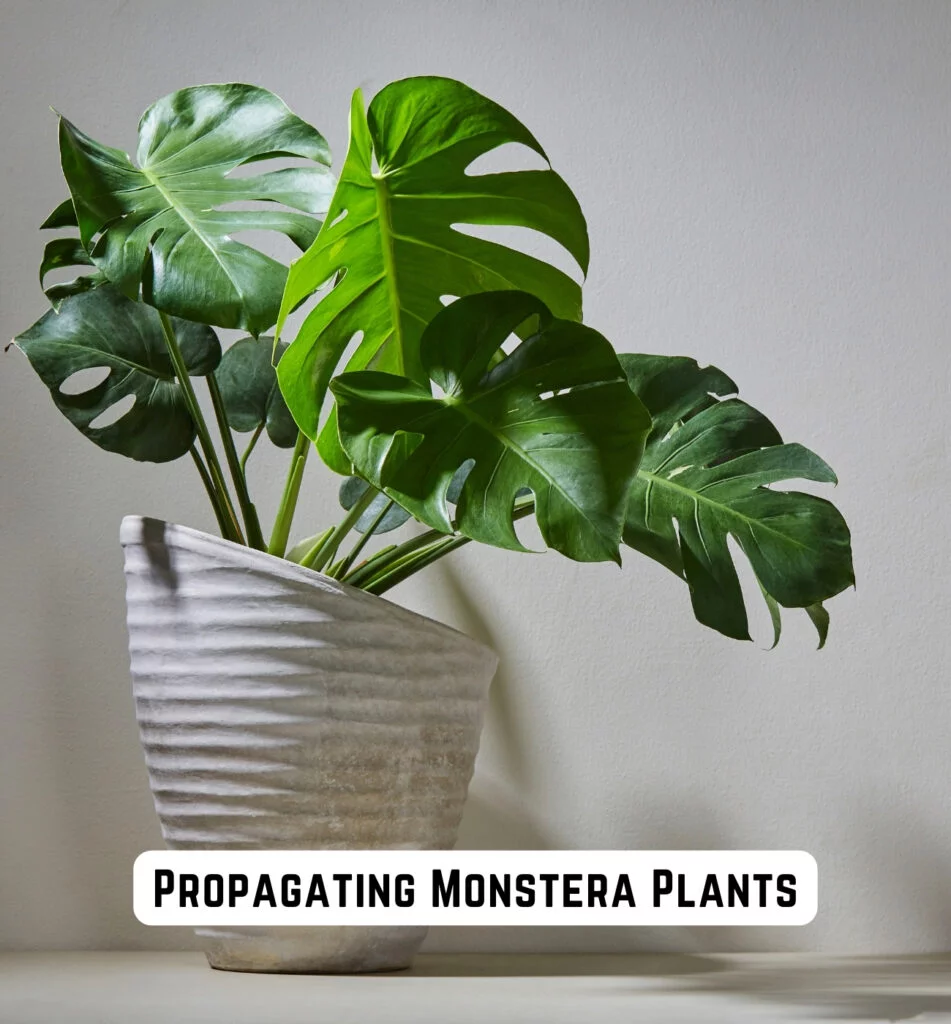
Expanding your Monstera collection or sharing these tropical beauties with others is easy through propagation. This section covers two main methods: stem cuttings and air layering.
Stem cuttings involve rooting a piece of the plant’s stem, while air layering encourages roots to form on a stem still attached to the parent plant. Detailed instructions for both techniques will guide you through the process of successfully propagating new Monstera plants.
Stem Cutting Method
Supplies Needed
- Clean, sharp pruning shears or a knife
- A healthy Monstera stem with at least one node (the point where a leaf or aerial root emerges)
- A well-draining potting mix
- A pot with drainage holes
- Rooting hormone (optional)
Step-by-Step Guide
- Choose a healthy stem and make a clean cut just below a node.
- Remove the bottom leaves and allow the cutting to callus over for a few days.
- (Optional) Dip the cut end in rooting hormone to encourage faster root growth.
- Plant the cutting in a well-draining potting mix, ensuring the node is buried.
- Water the soil and place the pot in a warm, bright location.
- Keep the soil moist but not saturated, and roots should emerge within a few weeks.
Recommended reading: Monstera adansonii Propagation – Ultimate Guide
Air Layering Method
Air layering is another popular propagation technique that allows you to root a section of the stem while it’s still attached to the parent plant. This method is generally more successful than stem cuttings but requires more patience and a longer time frame.
Here’s how to propagate your Monstera plant via air layering:
- Choose a healthy stem with a few leaf nodes (points where leaves emerge from the stem).
- Make a shallow cut into the stem, about 1-2 inches long, at one of the leaf nodes. That will help encourage root development.
- Apply a rooting hormone powder or gel to the cut area (optional but recommended for faster rooting).
- Pack moistened sphagnum moss around the cut area and wrap it tightly with plastic wrap or an air-layering pot. That will create a humid environment for root growth.
- Secure the moss bundle with ties or tape to keep it in place.
- Check the moss bundle periodically and keep it moist but not soaked.
- After several weeks to months, you should see roots emerging from the moss bundle.
- Once the roots are well-developed (approximately 2-4 inches long), carefully cut the rooted section from the parent plant just below the root mass.
- Remove the moss and plastic wrap, and plant the newly rooted cutting into a well-draining potting mix.
Air layering is a slower process compared to stem cuttings, but it often yields better results and a more established root system. With patience and proper care, you’ll have a brand new Monstera plant to enjoy or share with others.
Recommended reading: How to Propagate Monstera Deliciosa
Final Conclusions
Mastering Monstera plant care is a rewarding journey that allows you to enjoy the beauty of this tropical wonder in your home or office. By providing the right environmental conditions, proper watering and fertilization, and addressing any issues promptly, you can ensure your Monstera thrives and continues to impress with its stunning foliage. Remember, patience and consistency are key – with a bit of love and care, your Monstera will be a showstopper for years to come.
Frequently Asked Questions
Water your Monstera when the top inch or two of the soil is dry. During the growing season, this may be every 5-7 days and less frequently in the winter months.
Yellow leaves can be a sign of overwatering, nutrient deficiencies, or insufficient light. Check your watering routine, fertilize regularly, and ensure the plant is receiving adequate bright, indirect light.
In their natural habitat, monsteras can grow up to 70 feet tall! However, as houseplants, they typically reach 6-10 feet in height with proper care and support.
Yes, pruning is recommended to maintain the plant’s shape and encourage bushier growth. Remove any damaged, dead, or overly long stems with clean, sharp pruning shears.
Signs that your Monstera needs a larger pot include roots growing out of the drainage holes, slow growth, or the plant becoming top-heavy. Repot in the spring using a well-draining potting mix and a pot only 2-4 inches larger than the previous one.
If this post about Monstera plant care was helpful, please share it:
